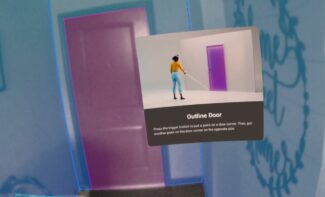A new experimental room setup feature on Quest 2 allows owners to map out their walls, doors, windows, and furniture for a new class of mixed reality experience.
The new “Room Setup – Experimental” feature sees you mark out surfaces in your home to build out a basic outline of your walls and the objects within. Using the feature I was able to quickly make boxes for a table as well as an island in my kitchen. These two surfaces are on either side of my typical play space, and having them represented in VR made it so I could easily leave my Oculus Touch controllers on either surface without taking the headset off. That’s of course just the beginning as developers figure out creative ways to incorporate furniture and walls into their mixed reality apps.
The feature appeared in the settings of one of our Quest 2 headsets running v40 of the system. The new feature could be activated separate to the existing computer vision-based safety systems on Quest 2 (Space Sense and Guardian boundaries) with the experimental feature built around a more robust “Scene Understanding” that was originally previewed last year during Meta’s Connect event.

“Bring the walls, furniture and objects from your room into VR so you can use apps that blend your real and virtual environments,” a dialog for the feature notes.
Late last year, developer Bob Berkebile built and released a free tool that enabled similar functionality, and some developers have been exploring these features in their Quest 2 apps on an individual basis as well. Notably, Berkebile lists on Linkedin he started at Meta in January of this year.
Earlier this month, Meta teased a new experience called The World Beyond coming to App Lab as a showpiece for the functionality. Meta said The World Beyond would launch with v40 of the software development kit for Oculus developers, but as of this writing v39 is still the latest version on the Oculus developer site.
I was able to test the new experimental room setup feature in the video below.
Later this year Meta is planning to sell a high-end standalone headset, currently known as Project Cambria, for significantly more than $800. It’ll feature a depth sensor and color passthrough views from higher resolution cameras that’ll likely make mixed reality experiences on that headset far more impressive.





